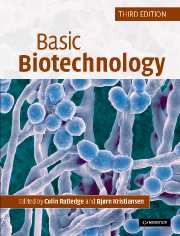Book contents
- Frontmatter
- Contents
- List of contributors
- Preface to the second edition
- Preface to the third edition
- Part I Fundamentals and principles
- Part II Practical applications
- Chapter 12 High-throughput screening and process optimisation
- Chapter 13 The business of biotechnology
- Chapter 14 Amino acids
- Chapter 15 Organic acids
- Chapter 16 Microbial polysaccharides and single cell oils
- Chapter 17 Environmental applications
- Chapter 18 Production of antibiotics by fermentation
- Chapter 19 Strategies of cultivation
- Chapter 20 Enzyme biotechnology
- Chapter 21 Recombinant proteins of high value
- Chapter 22 Insect and mammalian cell culture
- Chapter 23 Plant cell biotechnology
- Chapter 24 Biotransformations
- Chapter 25 Immunochemical applications
- Index
Chapter 17 - Environmental applications
Published online by Cambridge University Press: 05 June 2012
- Frontmatter
- Contents
- List of contributors
- Preface to the second edition
- Preface to the third edition
- Part I Fundamentals and principles
- Part II Practical applications
- Chapter 12 High-throughput screening and process optimisation
- Chapter 13 The business of biotechnology
- Chapter 14 Amino acids
- Chapter 15 Organic acids
- Chapter 16 Microbial polysaccharides and single cell oils
- Chapter 17 Environmental applications
- Chapter 18 Production of antibiotics by fermentation
- Chapter 19 Strategies of cultivation
- Chapter 20 Enzyme biotechnology
- Chapter 21 Recombinant proteins of high value
- Chapter 22 Insect and mammalian cell culture
- Chapter 23 Plant cell biotechnology
- Chapter 24 Biotransformations
- Chapter 25 Immunochemical applications
- Index
Summary
Introduction
Until recently, sanitary engineering monopolised environmental-related industrial activities. Because sanitary engineering gradually developed as an off-shoot of civil engineering during the past century, emphasis has been on conventional engineering techniques in which the bio component is largely ignored and dealt with stochastically rather than mechanistically. Sanitary engineering is well established for:
the catchment, treatment and distribution of drinking water;
the treatment of wastewater;
the treatment and disposal of solid wastes, e.g. municipal;
the treatment of industrial off-gases.
Many of the conventional technologies used in sanitary engineering are, however, perfect illustrations of Murphy's law in that they transform one problem into another often more intractable one, as when water pollutants are stripped into the air or concentrated and dumped in the soil. Environmental strategies have to be conceived with respect to the whole of the environment in a long-term perspective. This integrated holistic approach requires a detailed knowledge of environmental biology and, more particularly, of the functioning of complex microbial communities. The new focus on the environment as a whole and on the detailed functioning of the bio component has led to the development of new industrial activities, referred to as environmental biotechnologies. These must address formidable environmental problems now facing the world:
acid rain and ozone depletion;
enrichment of ground and surface waters with nutrients and recalcitrant pesticides;
recovery of reusable products and energy from wastes;
soil remediation;
disposal of animal manures.
- Type
- Chapter
- Information
- Basic Biotechnology , pp. 403 - 432Publisher: Cambridge University PressPrint publication year: 2006
- 1
- Cited by



